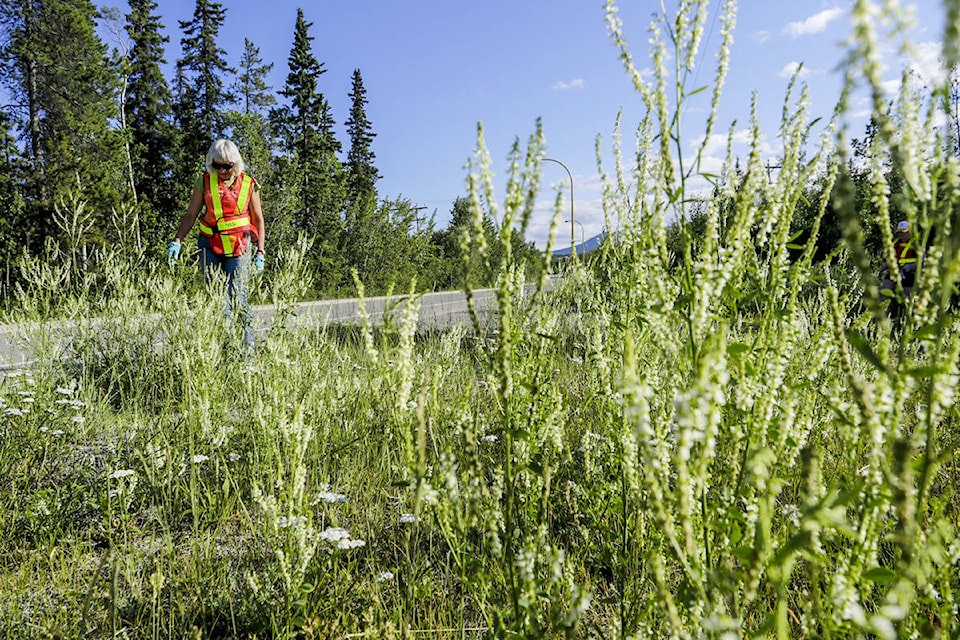In a disappointing turn of events, I recently learned that one of my favourite wildflowers is actually not a flower, but a marauding invader.
Narrow-leaf hawksbeard are, according to the Yukon Invasive Species Council website, an invasive plant which “once established is hard to remove.” Not knowing their proper name, I had been calling them tall dandelions because their small, bright yellow flowers have a mild resemblance to the native plant and because their blossoms also turn to white fluff when the plant goes to seed. I routinely pick large bouquets of them to brighten up my cabin because they last a few days when cut and seem to be everywhere which is unsurprising, since each plant produces around 49,000 seeds.
While pretty in its own way, narrow-leaf hawksbeard, along with thistle and sweet clover, is one of the most troublesome invasive plants in the Yukon, said Andrea Altherr, program coordinator for the YISC.
“They impact our agriculture tremendously,” Altherr said. “If you get them in your farm field, they can reduce productivity. They also negatively impact biodiversity, pushing out native species.”
The YISC lists 21 invasive species of plants in the Yukon. You often see these plants every day and probably don’t know they’re non-native. Environment Yukon also has a list of invasive plant species on its website, and lists hawksbeard, a member of the sunflower family, as common and highly invasive in the Yukon. It was first introduced accidentally in 1957 via transportation routes.
Many of these plants are introduced through seeding projects, Altherr said, especially where certified weed-free seed isn’t used. The invaders simply hitch a ride along with the species intended to be seeded.
“We often create perfect environments for these invasive species with roadside work and spreading gravel around.”
Another common source is hay, said Altherr.
“If you’re importing hay … from the south, it’s probably got weeds in it,” she said. The only real way to prevent this is by buying from local producers, she said.
Many invasive plants come from careless gardeners growing southern ornamentals, which then escape and colonize wild areas where people never intended them to grow, says Altherr. A widespread example of this is the creatively-named greater butter and eggs, a flower which closely resembles snapdragon. The plant was first introduced to the Yukon through horticulture in 1970, and has since become endemic.
“They were brought up as an ornamental,” Altherr said. “And now that they’re established, they’re really hard to get rid of.”
Education is one of the most important tools in fighting invasive species, Altherr said, especially for farmers.
“If you have an invasive species in three fields,” she said, “and farmers A and B don’t do anything about it, but farmer C does, it doesn’t do anyone any good, because the seeds just blow back in from farmer A and farmer B’s fields.”

Altherr said that, despite invasive species concerns, the Yukon “does not have any invasive species regulation.” There are regualtions in the territory’s forestry and quartz mining acts meant to control invasive species.
Environment Yukon could not muster anyone to comment for this story.
While accidental transportation and agriculture have brought in some invasive species, Altherr said that climate change has also had a huge impact on invasive species in the Yukon.
“You know, some people, they sometimes say ‘why wasn’t this a problem 10 years ago?” she said. “The answer is climate change. New species spread like crazy (in the new climate). Species make their way up from down south much faster than they used to.”
Once invasive plants are established, they are very difficult to eradicate or control, said Altherr. One of the most invasive plants in the Yukon, white sweet clover, has recently been the target of YISC-hosted community weed pulls, which are aimed at reducing the species in certain areas by physically removing it. White sweet clover is exceptionally resilient, with each plant capable of producing 300,000 seeds, which can germinate for up to 30 years. The most recent weed pull was held in Riverdale July 19, but people in the Takhini Valley area can participate in a similar event July 25.
YISC is also hosting a weed-pull at the old dump where a invasive species of vetch — which can push out other species and change nitrogen compositions in soil — has taken root. The infestation is limited to this area for the time being, Altherr said, but this particular species is still a threat.
“This plant is only growing in disturbed areas, but it can grow into forests (and spread) that’s what makes it so special,” she said.
“We like to try to tackle these things before they get out of hand.”
For more information on the YISC and its community events, people can visit yukoninvasives.com or the YISC Facebook page.
Contact Lori Garrison at lori.garrison@yukon-news.com
